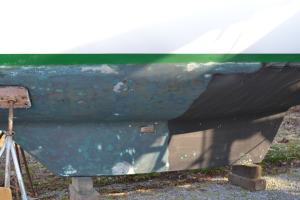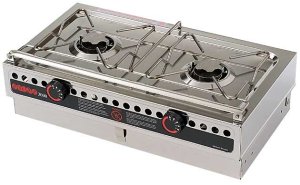Grinding Paint and Planning Galley Projects
Another spring-like day in Maryland. Temperatures were near 50 degrees and the sky was cloudless. Early this afternoon I walked to the boatyard to sand off more bottom paint, and ground off another 2.5 linear feet old antifouling paint. I would have done more but ran out of sanding discs. A check at the local hardware store revealed they didn’t carry the gauge I wanted (36-grit), so I was done for the day after a couple hours of sanding. That’s about right anyway. Repetitive motion injuries are really easy to get when you pass 55 years. Notwithstanding, here is photographic evidence of my labor.
While I had the camera with me, I took a few shots of the next interior project: a new galley stove installation. The old Princes or Hillerange (I can’t remember which brand it was) was installed in the galley counter top. Here is a photo of the cut out and another of the filler piece I installed when I threw the old stove away.
I know everything is a compromise on a boat, but having the range in the counter like this has never made sense to me. With practically no counter space on a boat anyway, why fill any usable space with a stove? The stove makers usually provide a cutting board to fit on top of the burners so that you can use is as a work area when the stove isn’t in use, but I don’t like that either. It’s just not that hard for a clever designer to come up with a more elegant solution.
I threw the old pressure alcohol stove away because it didn’t work and the rebuild kit was outrageously expensive, if you could find it. Until last year, we used a propane camp stove set on the counter top. It stored under the counter (you can just see it on the right side of the photo above). I’ve become uneasy about propane appliances that are not rated for indoor use. They are a safety compromise at best, if not down-right unsafe, and I have anecdotal reasons wanting to stop using the camp stove. The propane had to go, but that meant I had to decide where to install the new non-pressure alcohol stove.
The answer: Watkins Yachts included a chart table on the port side that folds down. It is nearly useless for chart work as it’s too small. If I ever did chart work below, it would be at the dining table. However, the old chart table will make a great storage and in-use place for the stove.
The storage position for the stove will be next to the hull behind the folded-up table top. I will install a substantial fiddle aft to keep it in place while underway. While in use, it will be moved out on to the table, again secured in place by appropriately located fiddles.
Here is a photo of the stove. According to the measurements I’ve taken, it will fit perfectly in the storage position, and there is ample room for it in the in-use position. This leaves the galley counter top clear for food preparation, and preserves the storage area underneath the counter. We keep a lot of stuff down there when we’re cruising.
And now for something completely different: a few words and images (mostly images) of boat names I don’t understand or can’t believe. These are always fun ponder… “what does that mean?” or “why would anyone name a boat that.”
Yeah… I’m not sure I get it. I mean, I get the play on words (C for Sea) – but… is there more to it? On to the next one:
This is a charter boat on the creek, and I see it often. But I gotta confess, I don’t get it. Just seems like a mixing of subjects that don’t really work together.









I’m sure you will enjoy the fruits of your labor!
Thanks David. A day working on the boat is better than a day working on anything else.